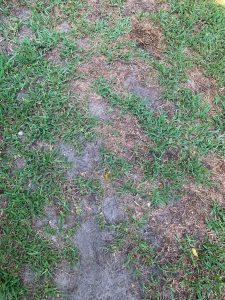Typically, this time of year many homeowners are tackling a variety of weeds in their landscapes. One of those weeds may very well be the invasive and aggressive weed known as Doveweed (Murdannia nudifflora). Doveweed emerges when average temperatures reach 65-70 degrees daily and germination continues into late fall.
Doveweed is easily mistaken as St. Augustine turf, since they bare resemblance in plant structure, so it is easy to blend into your turfgrass. This often gives homeowners a false sense of a beautiful green lawn, but this is only a mirage. The doveweed creeps in and slowly chokes off your sod, but you will not realize it because it does not appear to be that way. By winter, the doveweed will begin to die out, leaving grassless gaps throughout your lawn.

Another important factor to know about doveweed is that it causes serious dermatitis in dogs. I experienced this personally with my two dogs. Years ago, we purchased a house that was previously planted with St. Augustine sod. After a few weeks of living in our home, our dogs (who are indoor dogs) began developing serious rashes all over their bellies. At first, we thought there must be fleas in our backyard, however, after consulting with our local veterinarian, we were told that it appeared to be contact dermatitis.
For the next few months, we did everything we could possibly think of to keep them rash-free and figure out what the problem was. Fast-forward to November and suddenly all our backyard appeared to be dying out. I called the local Extension agent at the time, and she made a site visit and immediately identified that it was doveweed dying off, not our sod. She then asked, if our dogs ever have dermatitis issues, and immediately we figured out the answer. Once our agent showed us the difference between St. Augustine grass and doveweed, we realized that both our front and back yard were mixed with it, and even worse, it was growing all over our neighborhood. By winter, it appeared as if half of our yard had died off, only for it to later come back the following spring.
It is important to note that doveweed not only grows in St. Augustine grass, but is often found growing in Bermuda, hybrid Bermuda, and zoysia grasses. It favors poorly drained soils or areas that hold a lot of water. Doveweed consists of creeping stems, known as stolons, which will stretch across your turf and into flower beds, rooting everywhere along the way. Though it mostly spreads by seed dispersal by wind, mowing, or water, it is segmented parts easily take root wherever they are located. As the temperatures begin to drop below 70 degrees in late fall, the plant produces more seeds that drop into the soil, where they can be stored for several years before germinating.
When trying to identify doveweed, look for low lying plants in your sod that have segmented body parts with pink to red nodes (pictured below). They also will produce small blue and/or white flowers, slightly smaller than a dime.

Controlling doveweed can be a challenge. Having a healthy lawn is the best way to manage and control the spread of doveweed. A healthy lawn will almost always outcompete weeds. Consider using the integrated pest management (IPM) approach when managing doveweed. Start off by trying to change the environmental conditions that are attracting doveweed. Remember the plant loves poorly drained areas. Applying soil amendments to help with drainage and/or creating a way for excess water to drain away from your yard will certainly help.
Pull as many doveweed plants out by hand, being diligent in discarding the plants appropriately so they do not take root elsewhere. If there are too many to pull up at once, use a mower bag when mowing and discard your clippings so you do not spread the plant parts around your yard. Try to mow often enough so they do go to bloom, as blooming with create new seeds.
Finally, one of the best things you can do is to proactively plan. Follow UF IFAS’s gardening calendar to know when the best time is to apply a pre-emergent to your sod. Pre-emergence can not only slow the rate of germination, but kill off any potential seeds from germinating.
 5
5
